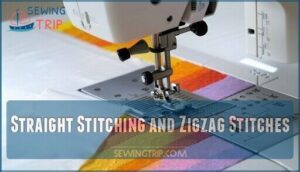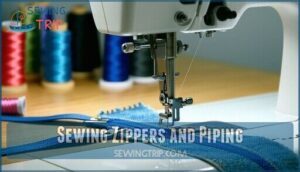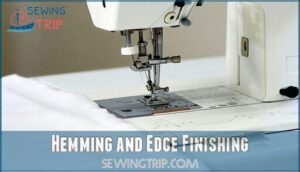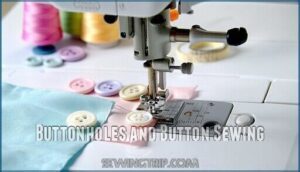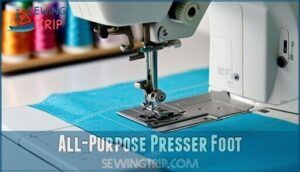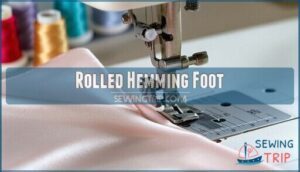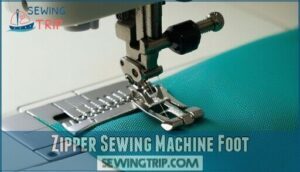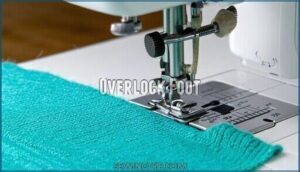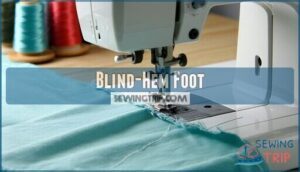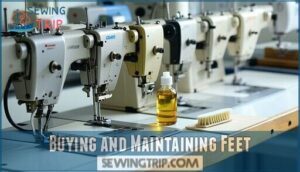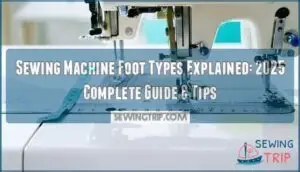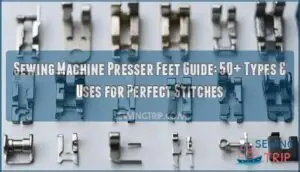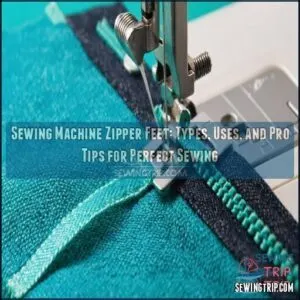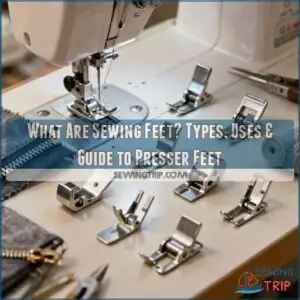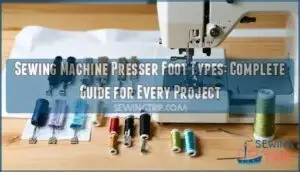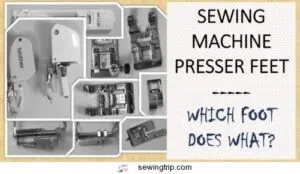This site is supported by our readers. We may earn a commission, at no cost to you, if you purchase through links.

You’ll need specialized presser feet for different techniques – a zipper foot for smooth zipper installation, buttonhole foot for perfect buttonholes, blind hem foot for invisible hems, and rolled hem foot for delicate edges.
Each foot guides fabric differently, ensuring precise stitching.
Your all-purpose foot works for basic sewing, but specialized feet like overcast, bias binding, and invisible zipper feet tackle specific challenges with ease.
Understanding which foot matches each task eliminates guesswork and frustration.
The right combination of technique and equipment makes even complex projects surprisingly manageable, allowing for a variety of sewing tasks, including the use of an invisible zipper foot.
Table Of Contents
- Key Takeaways
- Sewing Machine Feet Basics
- Top 9 Sewing Machine Feet
- 1. Zig Zag Sewing Machine Presser Foot
- 2. Low Shank Zipper Foot Sewing Machine
- 3. Invisible Zipper Foot Low Shank
- 4. Snap On Buttonhole Presser Foot
- 5. Snap On Button Sewing Foot
- 6. Babylock Brother Blind Hem Presser Foot
- 7. Narrow Rolled Hem Presser Foot Set
- 8. Adjustable Bias Binder Foot Low Shank
- 9. Snap On Overcast Presser Foot
- Presser Foot Uses Explained
- Choosing Right Presser Feet
- Buying and Maintaining Feet
- Frequently Asked Questions (FAQs)
- Conclusion
Key Takeaways
- You’ll transform basic sewing into professional results by matching specialized presser feet to specific tasks – using zipper feet for smooth installations, buttonhole feet for perfect closures, and hem feet for invisible finishes.
- Your machine’s shank compatibility determines which feet you can use – most domestic machines use low shank (½ inch from needle to screw), while industrial models use high shank (1 inch).
- Essential feet include all-purpose, zipper, buttonhole, and blind hem options – these four handle 80% of common sewing challenges and provide the foundation for expanding your collection.
- Proper maintenance extends foot lifespan significantly – clean with rubbing alcohol after each project, store in labeled compartments, and replace any feet showing cracks or bent parts.
Sewing Machine Feet Basics
Your sewing machine’s presser foot acts as the steady hand that guides fabric through each stitch, ensuring clean seams and protecting your fingers from the needle.
Your presser foot transforms every stitch into professional results.
Understanding different presser feet types and their compatibility with your machine’s shank system opens up endless creative possibilities for your sewing projects.
Presser Foot Functions
Your presser foot consistently serves as the backbone of every sewing project, controlling fabric feeding and ensuring stitch accuracy.
This essential component holds material firmly against feed dogs while protecting your fingers from needle injuries. Without proper presser foot function, achieving professional results becomes nearly impossible.
Here’s what makes presser feet indispensable for sewing machine foot applications:
- Finger protection keeps hands safely away from moving needles
- Material holding maintains consistent fabric tension throughout seams
- Technique foundation supports mastering various sewing machine feet functions
- Stitch accuracy delivers uniform results across different fabric weights
Understanding presser foot uses transforms your sewing from amateur to polished craftsmanship.
Presser Foot Types
Your sewing machine comes equipped with different presser foot types designed for specific tasks.
Most modern machines use snap-on feet that attach quickly with a simple click, while older models require screw-on feet that need manual attachment.
For tasks like creating a blind hem, you’ll need to know how to attach snap on.
| Foot Category | Primary Use | Common Examples | Best Results |
|---|---|---|---|
| Basic Feet | Everyday sewing | All-purpose, straight stitch | General construction |
| Specialty Feet | Specific techniques | Quilting Feet, Hemming Feet | Professional finishes |
| Decorative Feet | Creative projects | Embroidery, satin stitch | Artistic details |
| Hardware Feet | Closures & trims | Zipper Feet, buttonhole | Functional elements |
Understanding these sewing machine feet types helps you choose the right tool for each project, ensuring your stitches look professional every time.
Low Shank and High Shank Compatibility
Shank Height Guide matters when buying sewing machine feet. Measuring shank height determines compatibility.
Low shank machines measure ½ inch from needle plate to screw center; high shank machines measure 1 inch. Most domestic models use low shank.
Check your machine model lookup specifications first. Universal shank feet with adapters can bridge compatibility gaps between different shank type systems.
Knowing your machine’s shank type identification is essential for accessory compatibility.
Top 9 Sewing Machine Feet
You’ll find these nine essential presser feet transform your sewing projects from basic to professional with minimal effort.
Each foot serves a specific purpose that makes complex techniques simple and gives you the tools to tackle any sewing challenge with confidence.
They help you to achieve professional results by making it easier to perform various sewing tasks.
1. Zig Zag Sewing Machine Presser Foot
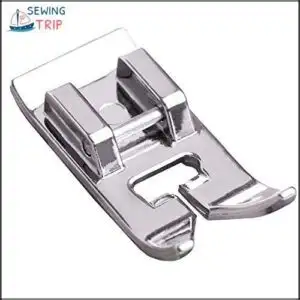
Your sewing machine’s zig zag foot opens up countless creative possibilities beyond basic straight stitching.
This wide-slotted powerhouse handles decorative stitches with ease, making it perfect for appliqué work and embellishment projects.
When working with stretch fabrics like jersey or spandex, this foot prevents puckering while maintaining fabric elasticity.
You’ll love how it accommodates twin needles for professional-looking hems and topstitching.
The adjustable zigzag width lets you customize stitch appearance, while varying stitch density creates different textures and effects.
This versatile foot transforms your machine into a decorative powerhouse.
Whether you’re reinforcing seams on activewear or adding artistic flair to home décor projects, it delivers consistent results.
The wide opening prevents thread buildup, ensuring smooth operation even with thick decorative threads.
Best For: Sewers wanting one foot that handles multiple techniques, from basic mending to creative embellishment work.
2. Low Shank Zipper Foot Sewing Machine
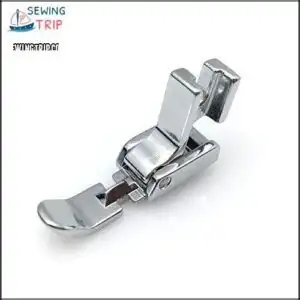
While zigzag feet handle basic tasks, you’ll need specialized tools for perfect zipper installations.
A zipper foot transforms challenging zipper projects into manageable tasks.
Its Low Shank Design fits most domestic sewing machines – including Singer, Brother, Janome, and Kenmore models.
This sewing machine foot features a narrow profile that provides excellent Needle Clearance around zipper teeth.
You can position the needle on either side, giving you flexibility for different Specialty Zippers and applications.
The Zipper Foot Materials are typically durable plastic, making them affordable yet reliable.
Installation takes seconds – simply remove your current presser foot and snap this one in place.
Foot Pressure Adjustment remains consistent with your machine’s settings.
The narrow design lets you stitch incredibly close to zipper coils, creating professional-looking seams.
Most sewing machine feet collections include this versatile attachment, but standalone options cost just a few dollars.
Perfect for garment construction, home décor projects, and bag making.
3. Invisible Zipper Foot Low Shank
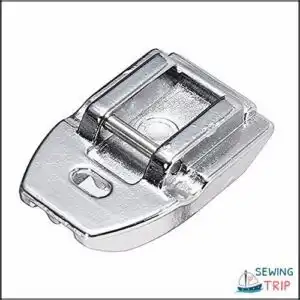
While regular zippers get the job done, invisible zipper foot takes your projects to the next level with that polished, professional look.
This specialized foot features two parallel grooves that cradle zipper teeth perfectly, ensuring smooth installation every time.
Foot installation is straightforward on most low shank machines – just snap it on and you’re ready to go.
The grooves guide your needle position automatically, making even tricky fabric choices manageable:
- Lightweight fabrics: Perfect for dresses and blouses without puckering
- Medium-weight materials: Ideal for skirts and home decor projects
- Stretchy knits: Maintains fabric integrity while creating clean closures
Different zipper types work beautifully with this foot, from polyester to metal options.
When troubleshooting tips come in handy, remember that practice makes perfect – test on scraps first to nail your technique before tackling your main project.
4. Snap On Buttonhole Presser Foot
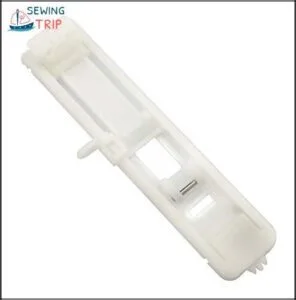
Creating professional buttonholes becomes straightforward when you’ve got the right buttonhole foot for your sewing machine. This specialized presser foot transforms what once required tedious hand-sewing into a quick machine process.
Your buttonhole foot automatically measures button sizes and creates matching openings without manual calculations. Simply place your button in the foot’s measuring slot, and it determines proper buttonhole sizes for perfect fit every time.
The foot’s clear markings help with buttonhole placement, ensuring consistent spacing across garments. This sewing machine foot handles various fabric compatibility needs, from lightweight cotton to medium-weight denim.
You’ll control stitch density through your machine’s settings, creating tight, secure edges that won’t fray with wear. Most sewing machine presser feet in this category work with low-shank machines, though some require foot adjustments for proper alignment.
These feet help maintain consistent stitch quality across projects. The snap-on design means quick changes between different sewing machine feet during projects.
Best For: Sewists wanting consistent, professional buttonholes without hand-sewing time investment.
5. Snap On Button Sewing Foot
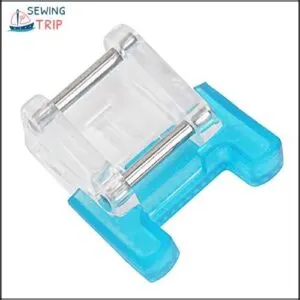
Hand-sewing buttons takes forever, but your button sewing foot changes everything. This specialized attachment transforms tedious manual work into quick machine stitching.
Here’s why you’ll love this sewing machine foot:
- Universal compatibility – Works with various button size options and fabric types from cotton to denim
- Perfect positioning – Holds buttons steady while you control stitch settings for secure attachment
- Time efficiency – Completes button attachment in seconds versus minutes of hand-sewing
The foot accommodates different shank height requirements and button thicknesses. Simply place your button under the foot, select zigzag stitch, and let your machine do the work.
Most sewing machine feet collections include this essential tool. While alternative methods like hand-sewing exist, machine button sewing delivers consistent results every time.
Compatible with Brother, Janome, and other popular brands, this sewing machine feet uses make garment construction faster and more professional-looking.
6. Babylock Brother Blind Hem Presser Foot
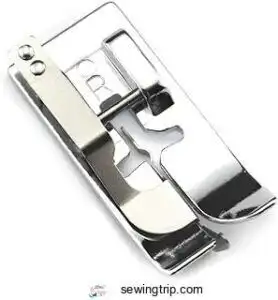
Beyond simple hemming, this specialized sewing machine foot creates flawless blind hems that remain invisible from the garment’s right side.
The Babylock Brother Blind Hem Presser Foot features a metal guide that positions fabric precisely while you stitch.
| Feature | Description | Benefit |
|---|---|---|
| Metal Guide | Aligns fabric fold perfectly | Professional results every time |
| Snap-On Design | Quick installation process | Easy switching between feet |
| Low Shank | Compatible with most machines | Versatile usage options |
Blind Hems Explained: This technique catches just a few threads from the fabric’s front, making stitches nearly invisible.
Foot Compatibility works with Brother, Babylock, and most low shank sewing machines.
Stitch Settings require blind hem stitch selection on your machine.
Fabric Types include woven materials like cotton, linen, and wool.
Troubleshooting Guide: If stitches show, adjust the guide position slightly.
This blind hem foot transforms your sewing machine into a professional hemming tool, delivering clean finishes on pants, curtains, and garments without hand-sewing time.
7. Narrow Rolled Hem Presser Foot Set
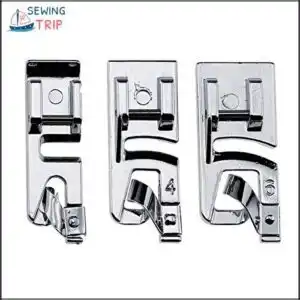
The narrow rolled hem presser foot set transforms hemming from a tedious chore into smooth sailing.
You’ll get three different foot sizes (3mm, 4mm, and 6mm) that automatically curl fabric edges while you stitch, creating those crisp, professional-looking finishes you see on store-bought garments.
Fabric suitability matters here – this foot works best with lightweight fabrics like chiffon, silk, and cotton voile.
Thick materials won’t feed properly through the foot’s curved channel.
Needle position should stay centered for ideal results.
Practice hemming curves by starting with straight edges first.
Feed your fabric through the foot’s groove, letting it guide the rolling action.
The different foot sizes accommodate various fabric weights and desired hem widths.
This sewing machine feet essential shines on scarves, napkins, and delicate blouses where hand-rolled hems would take forever.
Your presser feet guide arsenal isn’t complete without this time-saving tool that delivers consistent results every time.
8. Adjustable Bias Binder Foot Low Shank
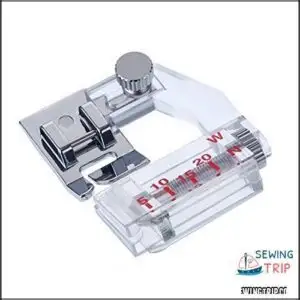
With the adjustable bias binder foot, you’ll transform binding from a tedious chore into a streamlined process.
This time-saving attachment works with most low shank sewing machine feet, including Brother, Janome, and Singer models.
The foot neatly folds and stitches pre-folded bias tape in one smooth operation, handling various Bias Tape Sizes from 5mm to 20mm wide.
Here’s what makes this bias binder foot essential:
- Foot Adjustment Guide: Simple dial adjustments accommodate different tape widths without switching attachments
- Binding Edge Types: Works perfectly on necklines, armholes, and quilt edges for professional results
- Cornering Techniques: Built-in guides help navigate curves and corners with consistent binding placement
- Fabric Thickness Guide: Best performance on lightweight to medium fabrics with pre-folded tape
While mastering this sewing machine presser foot requires practice, the payoff is perfectly bound edges without wrestling matches.
You’ll appreciate how this low shank attachment eliminates the usual frustration of binding projects.
Best For: Quilters and sewists using low shank machines who want efficient binding on lightweight to medium fabrics.
9. Snap On Overcast Presser Foot
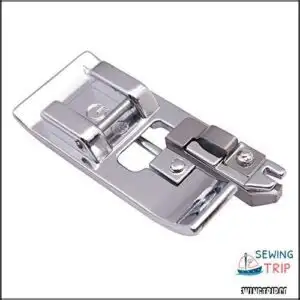
While bias binding creates neat edges, the snap-on overcast foot offers another approach to fray prevention. This serger alternative transforms raw edges into professional finishes using your regular sewing machine.
The overcast foot’s center bar guides thread around fabric edges, creating wrapped stitches that prevent unraveling. You’ll get clean results on various fabric types – from delicate silks to sturdy denims. Multiple stitch options work with this versatile foot, including zigzag and specialty overcast patterns.
| Feature | Benefit |
|---|---|
| Metal construction | Long-lasting durability |
| Center guide bar | Perfect thread placement |
| Universal snap-on | Easy attachment/removal |
| Multiple stitch compatibility | Versatile edge finishing |
| No-serger solution | Cost-effective professional results |
Compatible with Brother, Singer, and Babylock models, this sewing machine foot delivers consistent results. The snapon design makes switching between different sewing machine feet types quick and simple, helping you master various sewing machine foot uses without investing in expensive equipment.
Presser Foot Uses Explained
Now you can master each presser foot’s specific purpose and transform your sewing projects with professional results.
Understanding when and how to use different feet will expand your creative possibilities and improve your stitching accuracy.
Straight Stitching and Zigzag Stitches
With straight stitching and zigzag stitches, your all-purpose sewing machine feet become the workhorses of every project. These types of feet handle most fabric challenges when you master the basics.
Straight stitch success depends on three key adjustments:
- Stitch length – shorter for thick fabrics, longer for lightweight materials
- Needle position – move left or right for precise seam finishes
- Tension settings – balanced thread creates professional results
Your zig zag foot excels with stretch materials and decorative sewing foot uses, preventing puckering across different fabric type combinations.
Sewing Zippers and Piping
Beyond basic stitches, you’ll need specialized sewing machine feet for professional zipper types and piping techniques. Your zipper foot becomes your best friend when installing closures and creating corded edges.
Standard zipper feet work perfectly for exposed applications, while the invisible zipper foot features grooves that guide teeth for seamless welt insertion. For thicker projects, adjustable options let you position the needle exactly where needed.
| Foot Type | Primary Function |
|---|---|
| Standard Zipper | Exposed zippers, basic piping |
| Invisible Zipper | Hidden closures with groove guides |
| Adjustable Zipper | Heavy fabrics, thick cording |
Piping foot usage transforms ordinary seam finishes into polished details. The grooved underside keeps cording aligned while you stitch, preventing the wobbling that ruins clean lines. When sewing foot uses overlap, your zipper foot can handle light piping work too, making it a versatile addition to your collection.
Hemming and Edge Finishing
Hemming and edge finishing transform raw fabric edges into professional-quality pieces.
Your sewing machine’s specialized feet handle these tasks with precision.
Consider these essential hemming techniques:
- Blind hemming creates nearly invisible stitches using the blind hem foot’s guide system
- Rolled hems produce delicate, narrow edges perfect for lightweight fabrics with the rolled hem foot
- Overcast edges prevent fraying using the overlock foot’s zigzag encasing method
The blind stitch foot keeps hems hidden, while the hemmer foot creates consistent decorative edges and bias binding applications.
A presser foot kit offers themed collections.
Buttonholes and Button Sewing
Perfect hems lead naturally to button work, where buttonhole and button sewing feet shine. Your buttonhole foot creates automatic buttonholes sized exactly to your buttons.
Button placement becomes foolproof when you insert the button directly into the foot’s slot. The button sewing foot secures buttons while stitching, preventing shifting during attachment.
For shank buttons or thicker fabrics, adjust stitch width accordingly.
| Buttonhole Types | Best For |
|---|---|
| Standard | Lightweight fabrics |
| Keyhole | Heavy coats |
| Stretch | Knit garments |
| Corded | Reinforced openings |
These sewing machine feet transform tedious hand-sewing into quick, professional results.
Choosing Right Presser Feet
You’ll discover that selecting the right presser foot transforms your sewing projects from frustrating struggles into smooth, professional-looking results.
The key lies in matching each foot’s specific design to your project’s requirements, whether you’re creating clean hems, inserting zippers, or finishing raw edges, which can be a complete process to achieve professional-looking results.
All-Purpose Presser Foot
When you’re starting your sewing journey, the all-purpose presser foot becomes your trusty companion.
This versatile basic standard presser foot handles most beginner projects with ease, from simple seams to decorative stitches.
You’ll appreciate how it maintains excellent fabric feeding while ensuring consistent stitch quality across different materials.
The foot provides reliable seam accuracy whether you’re working with cotton, polyester, or lightweight fabrics.
Its design offers finger protection during operation, making it perfect for newcomers learning proper technique.
Most sewing machine feet collections start here because it’s your reliable foundation.
This sewing machine foot adapts to various presser foot types of stitching, making it indispensable for everyday projects.
It’s capable of handling straight and zigzag stitches efficiently.
Rolled Hemming Foot
A rolled hem foot transforms messy edges into professional finishes. This sewing machine foot guides fabric through a small funnel, creating perfectly folded hems automatically.
Fabric compatibility matters – lightweight materials like silk and cotton work best. Foot sizes range from 2mm to 6mm, matching your desired hem width.
Hemming techniques become effortless once you master the initial fabric feeding. Troubleshooting hems often involves adjusting thread tension or presser foot pressure.
Some narrow rolled hem foot models create decorative edges with zigzag stitches. These tools are available at various online retailers.
- Watch fabric magically curl into perfect tiny hems
- Feel satisfied seeing professional results on delicate materials
- Experience the joy of completing projects faster than hand-hemming
- Gain confidence tackling challenging curved seams and circles
Zipper Sewing Machine Foot
Your zipper foot’s narrow design lets you stitch incredibly close to zipper teeth without catching or jamming.
This versatile sewing machine feet attachment handles regular zippers, invisible zippers, and piping attachment tasks with ease.
Adjustable zipper options offer flexibility for different projects, while proper zipper foot maintenance prevents lint buildup that compromises precision basting techniques.
You can find specialized feet available for unique zipper applications.
Overlock Foot
The overlock foot serves as your serger alternative, wrapping thread around fabric edges to prevent fraying without needing expensive equipment.
This overcasting foot works perfectly with overlock stitch settings on your sewing machine, creating professional edge finishing on knits and wovens alike.
You’ll love how it secures seam allowance edges while maintaining stretch in knit fabrics, making it invaluable among sewing machine feet for preventing fabric fraying with consistent results.
Blind-Hem Foot
Your blind hem foot creates perfect invisible hems on pant hems and skirt hems without visible stitches.
The fabric guide keeps material aligned while you sew, making professional-looking pin tucks effortless.
This sewing machine foot works with your sewing machine’s blind stitch setting to fold fabric precisely. Simply adjust your needle position, and you’ll achieve flawless results every time.
Buying and Maintaining Feet
Investing in quality presser feet expands your sewing capabilities, but you’ll need to know where to shop and how to care for them properly.
Smart maintenance and storage practices will extend the life of your presser feet while ensuring they perform at their best for years to come, with proper care.
Where to Buy Sewing Machine Feet
You’ll find the best selection of sewing machine feet through multiple shopping channels.
Online Retailers like Amazon, MadamSew, and WAWAK offer extensive collections with competitive pricing – some sets include over 80 pieces for under $20.
Local Dealers provide brand-specific expertise and compatibility testing, while Sewing Shops stock quality sewing machine accessories with personalized guidance.
Craft Stores like JOANN carry popular sewing machine foot attachments from major sewing machine feet brands.
For a wide variety, consider exploring options for specialized presser feet.
Don’t overlook Flea Markets for vintage sewing machine parts – you might discover rare finds at bargain prices.
Presser Foot Maintenance and Storage
Proper sewing machine foot maintenance keeps your tools working smoothly for years.
Here’s your essential care routine:
- Cleaning methods: Wipe feet with rubbing alcohol after each project to remove thread residue and fabric oils
- Storage solutions: Use labeled compartments or magnetic strips to keep feet organized and easily accessible
- Rust prevention: Store in dry environments away from moisture that causes metal corrosion
- Damage inspection: Check regularly for bent parts, loose screws, or worn surfaces during routine maintenance
- Foot organization: Group similar feet together and maintain an inventory list for quick identification
Compatibility and Replacement Considerations
Check shank height first when selecting sewing machine feet compatibility. Low-shank and high-shank machines need matching feet.
Foot brands matter—generic universal feet work with adapters, while brand-specific options fit perfectly. Screw-on feet offer secure attachment for heavy-duty tasks.
Replace worn feet showing cracks or bent parts. Store feet in labeled containers to prevent loss.
Always test new sewing machine foot replacement on fabric scraps before starting projects to verify proper sewing machine compatibility.
Frequently Asked Questions (FAQs)
What type of Foot does a sewing machine use?
Your sewing machine uses a presser foot that sits beneath the needle to hold fabric steady while stitching.
You’ll typically start with an all-purpose foot, but can swap in specialized feet for zippers, buttonholes, hems, and decorative work.
Does a sewing machine have a presser foot?
Yes, every sewing machine has a presser foot.
You’ll find it positioned under the needle, holding your fabric firmly against the feed dogs.
It’s essential for creating even stitches and keeping your fingers safe.
Do sewing machine feet really matter?
Different feet dramatically change what you can achieve.
They’re like specialized tools – using the right one transforms amateur projects into professional-looking results with proper seam allowances, perfect hems, and flawless finishes.
What is a walking foot on a sewing machine?
Don’t count your chickens before they hatch – a walking foot can make or break your sewing success.
It feeds thick layers evenly through your machine, preventing puckering and ensuring smooth stitches on quilts and heavy fabrics.
How long does it take to put on a sewing machine foot?
Changing a sewing machine foot takes about 30 seconds.
You’ll lift the presser foot lever, press the release button, remove the old foot, align the new one, and lower the lever.
It’s quick and straightforward.
Are sewing machine feet compatible?
Like switching channels on your grandfather’s old television, most sewing machine feet aren’t universally compatible.
You’ll need to check your machine’s brand, model, and shank type before purchasing new feet to guarantee proper fit.
What are the most useful sewing machine feet?
The most essential feet you’ll need are the zipper foot, buttonhole foot, and blind hem foot. These three handle zippers, professional buttonholes, and invisible hems perfectly.
What are the uses of these sewing tools presser feet?
Ever wondered how your sewing machine creates perfect stitches?
Presser feet hold fabric steady against feed dogs, ensuring even feeding and accurate seams while protecting your fingers from the needle during sewing.
Why should you buy a sewing machine with a presser foot?
You’ll achieve professional results with precise stitching. A presser foot holds fabric steady, prevents skipped stitches, protects your fingers, and guarantees consistent seam allowances for quality projects.
Do sewing machine foot accessories work?
Imagine ruining a beautiful dress because your zipper foot slipped.
Yes, sewing machine foot accessories absolutely work when you choose quality ones that fit your machine properly and match your specific sewing needs.
Conclusion
Mastering sewing machine feet and their uses opens endless creative possibilities for your projects.
You’ll discover that each specialized foot serves a specific purpose, making complex techniques manageable for sewers at any skill level.
From installing zippers effortlessly to creating professional buttonholes, these tools eliminate common sewing challenges.
Invest in quality presser feet that match your machine’s compatibility.
With proper care and storage, they’ll serve you for years.
Start with essential feet like zipper, buttonhole, and hem feet, then expand your collection as your skills grow and projects become more ambitious.
- https://www.threadwerk.com/post/10-sewing-machine-feet-explained
- https://sewingformysanity.com/5-sewing-machine-presser-feet-every-sewists-needs/
- https://www.nationalsewingcircle.com/post/common-sewing-machine-feet-and-when-to-use-them
- https://www.youtube.com/watch?v=SYJ8P_czMEk
- https://www.sewjersey.com/blogs/quilting-tips/sewing-presser-feet-and-there-best-used-the-top-feet-to-own

